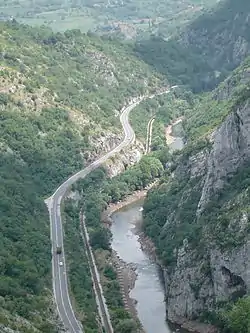Nišava
The Nišava or Nishava (Bulgarian and Serbian Cyrillic: Нишава, Serbian pronunciation: [nǐʃaʋa]) is a river in Bulgaria and Serbia, a right tributary, and with a length of 218 km[1] also the longest one, of the South Morava.
| Nišava (Nishava, Нишава) | |
|---|---|
 The Sićevo gorge, eastern Serbia | |
| Location | |
| Country | Bulgaria, Serbia |
| Physical characteristics | |
| Source | |
| • location | Bulgaria, Stara Planina mountains |
| Mouth | |
• location | Južna Morava, west of Niš, Serbia |
• coordinates | 43°22′14″N 21°46′08″E |
| Length | 218 km (135 mi)[1] |
| Basin size | 4,086 km2 (1,578 sq mi)[2] |
| Discharge | |
| • average | 36 m3/s (1,300 cu ft/s) at the mouth |
| Basin features | |
| Progression | South Morava→ Great Morava→ Danube→ Black Sea |
Bulgaria
The Nišava originates in western Bulgaria, in the Stara Planina mountains (east of Kom Peak) near the village of Gintsi. Its source is close to the Serbian border. It enters Serbia after 67 km of flow through Bulgaria without receiving any major tributaries.
Because it flows through Gintsi, the upper course of the river is known as Ginska (Cyrillic: Гинска). It first flows to the south, then sharply turns west into the Godech Kettle, passing through Razboishte, after which it forms a gorge. Coming out of the gorge, it reaches Kalotina, a major border crossing on the Bulgarian-Serbian border (Kalotina-Gradina), and continues to the west into Serbia.
Serbia
Flowing generally to the west for the remaining 151 km, it passes near Dimitrovgrad, Pirot, Bela Palanka, Niška Banja and Niš, one of the largest cities in Serbia, 10 km after which the Nišava empties into the Južna Morava. However, with the rapid growth of Niš in previous decades and its still fast growing suburbs, the banks of the Nišava are urbanized almost to its mouth.
After being divided into districts in 1992, the Nišava District (with Niš as administrative center) is named after the river.
Characteristics and importance
The river belongs to the Black Sea drainage basin. Its own drainage area covers 4,086 km2, of which about 73% in Serbia, the rest in Bulgaria.[2] The Nišava is not navigable. It is not only the longest tributary of the Južna Morava, but also the largest one in terms of discharge (36 km3/s). It has many smaller tributaries, the most important being the Temštica from the right, and the Jerma (or Sukovska reka), Crvena reka, Koritnička reka and Kutinska reka from the left.
The Nišava valley is part of a major natural route that from ancient times has connected Europe and Asia: the route follows the valleys of the Morava, Nišava and Maritsa and onwards towards Constantinople, present-day Istanbul. Both the Belgrade-Sofia-Istanbul road and the railway follow this route.
Nishava Cove in Rugged Island in the South Shetland Islands, Antarctica is named after Nishava.
In 2008, cultivation of various aromatic and medicinal herbs began in the Serbian section of the Nišava watershed and the valleys of its tributaries. In time, lavander became the major crop, spreading on numerous hills and mountain slopes. Other herbs include Roman chamomile, dwarf everlast, lemon balm, hyssop and Damask rose. Modified Mediterranean micro-climate in the valley, spreading from Greece and North Macedonia through the Niš and Leskovac basins in the South Morava valley, suits the herbs, so as the ph-neutral limestone terrain and altitude from 450 to 550 m (1,480 to 1,800 ft). Numerous eco-plantations and oil distilleries were built. By 2020, the region became known as Serbian Provence.[3]
Sićevo gorge
In its Serbian part, the Nišava carved a composite valley with several depressions (Dimitrovgrad, Pirot (or Basara; Cyrillic: Басара), Bela Palanka and Niš). However, the most prominent geological feature the river formed is the Sićevo gorge (Sićevačka klisura; Cyrillic: Сићевачка клисура) between Bela Palanka and Niška Banja. The river is quite powerful in the gorge, which is used for two power stations ('Sićevo' and 'Ostrovica') used for electricity production, irrigation and fishery. The gorge is 17 km long, 350–400 m deep, in some parts developing canyon like-structures (like inverse valley slopes at Gradiški kanjon; Cyrillic: Градишки кањон). The gorge itself carved through the Kunovica plateau between the southern slopes of the Mountains of Svrljig and the mountain of Suva Planina, and the surrounding areas are known for their high-quality vineyards. There is also a huge quarry in the gorge ('Ostrovica'), where six villages are located, the largest one being Sićevo that gives the name to the whole gorge.
References
- Statistical Yearbook of the Republic of Serbia 2017 (PDF) (in Serbian and English). Belgrade: Statistical Office of the Republic of Serbia. October 2017. p. 16. ISSN 0354-4206. Retrieved 30 May 2018.
- Velika Morava River Basin, ICPDR, November 2009, p. 2
- Anadolija (4 July 2020). "Mirisna polja lavande na jugu Srbije, eterična ulja za kupce iz EU" [Aromatic lavender fields in southern Serbia, essential oils for the EU byers] (in Serbian). N1.
See also
- PIM "Ivan Milutinović", Belgrade, Serbia ; Morava - Vardar (Axios) Navigation Route (About 1,200 km shorter route (three days shorter time of navigation) from Belgrade to Port of Thessaloniki than across Danube, Black Sea and Aegean Sea. Electric power production, improvement of water quality and regulation of flooding wave.)
- Morava - Vardar (Axios) Navigation Route map
- Hydropower and navigation system "Morava" (Concepts of regulation of rivers Great Morava and South Morava for navigation and hydropower production.)
External links
| Wikimedia Commons has media related to Nišava. |

